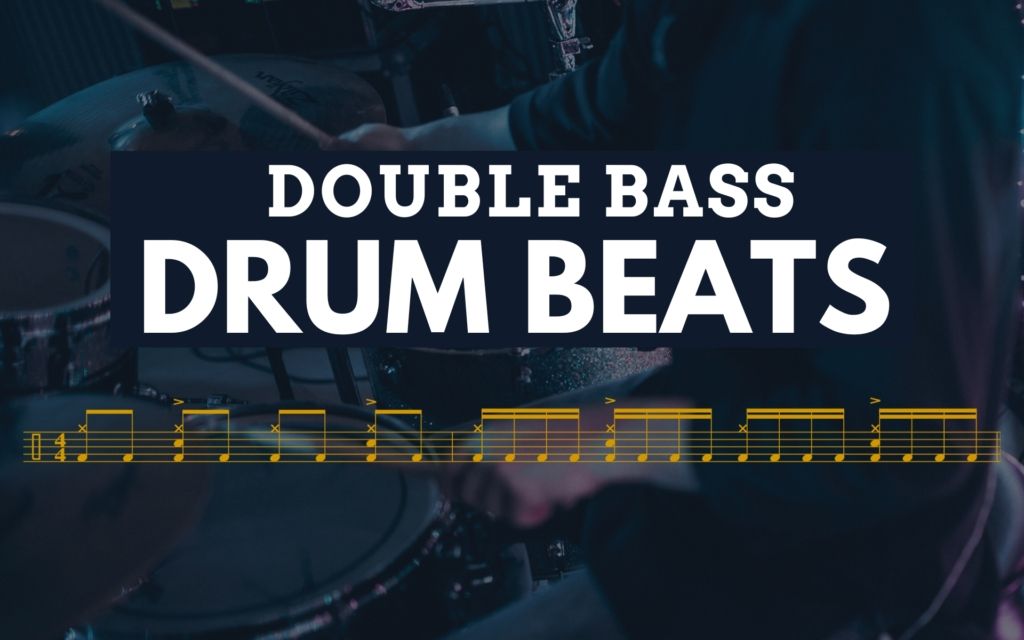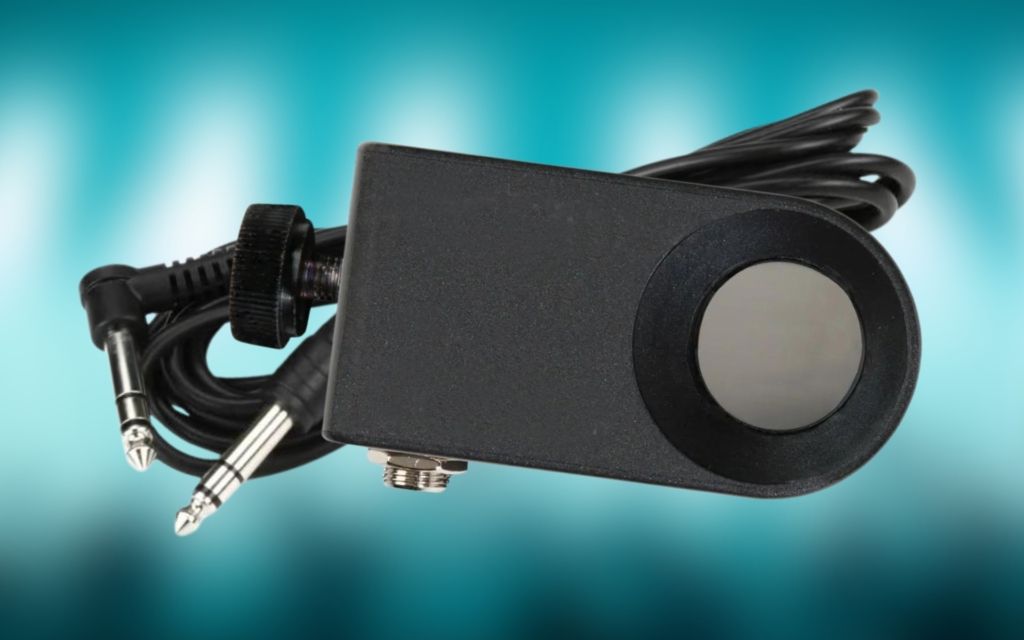If you’ve ever wanted to learn to play the drums, now is the best time to do it. With an unlimited number of online resources, it’s become easier than ever to pick up a pair of drum sticks and start learning.
Learning how to play drums is incredibly fun, yet somewhat challenging to most people at first. You’re going to be using your limbs in ways that you’ve never before. Learning drums is a long journey, but everyone tends to start in the same place.
So, think of this article as your first drum lesson. This guide will show you how to play some basic beats, learn more about what drumming is, and establish steps to improve over time. Let’s dive in!
Contents
Role of a Drummer
The goal of learning the drums is to become a timekeeper. A drummer will always be the anchor of a band, keeping time for everyone else to lean on. That should be your primary goal when learning the drums.
All musicians keep time and play rhythms, but you need to be the best at it when you’re playing the drums. It’s a supportive instrument by nature, so you’re most probably never going to be the frontman of a band.
The more that you’re aware of your role as a drummer, the more intentional you’ll be with what you practice. Keep that in mind!

Everything You Need to Learn the Drums
If you want to learn how to play the drum set properly, you’re going to need a few things. The most important thing would be a pair of drum sticks.
Once you have a pair of sticks, you can learn how to hold them and how to play a few basic hand patterns. There are these things called rudiments that come in very handy when you’re drumming.
Don’t worry too much about them right now, however, as we’re going to learn how to play some beats and fills instead to get you playing the drums as quickly as possible.
You’re also going to need a drum set. While drum sets can get very expensive, you can easily find affordable ones that have everything you need to play. Here is a list of great acoustic kits for beginners and here is another list of good electronic ones.
Things to Consider When Wanting to Learn the Drums
The biggest issue that all drummers have is noise. Drumming can get incredibly loud, so it’s usually not the instrument that your neighbors want you to play.
If you have an acoustic drum kit, the best thing to do is approach your neighbors and ask when a suitable time to play would be. Otherwise, you should get an electronic kit to avoid noise complaints.
Another thing to consider is space. Drums are also one of the biggest instruments that you can play. They typically take up quite a large portion of any room. Make sure you have enough space to put a kit before you get one.
There are some smaller kits available that you could also consider getting. However, they come as shell packs, meaning you’ll need to buy hardware and cymbals separately.
Learning How to Play Drums: The Basics
There are a few things you need to know that will help you when learning drums. These are things like drum setup, notation reading, technique, and basic drum parts. You can go down a deep wormhole for each of them and have entire lessons dedicated to a single topic.
However, I’m going to go through each of them briefly so that you can start playing things on the drums quickly.
Drum Setup

The way you set your drums up is important in establishing good habits and having ergonomic tendencies. Most beginner drummers get the drum setup wrong in a few ways, so make sure to research how to set your drums up properly.
Learn about all of the parts of a drum set so that you know what you’re working with. Once you know all the names of the drums, it will be easier to learn and understand what someone is teaching you to do.
You should also make sure that you’re sitting correctly at the drums. It’s important to establish good habits as soon as you start so that they’re solidified from the very beginning.
Too many drummers develop bad habits and then have to spend years fixing them. So, always check your posture while sitting at the kit. Having a straight back with your shoulders pulled back as well is a good place to start.
How to Hold Your Drum Sticks
Your sticks are the most important part of the whole setup. You can’t play the drum kit without them. So, you need to get very comfortable and familiar with them.
In terms of stick holding technique, there are several ways you can do it. However, most drummers use what is called matched grip.
This is when to hold the stick tightly between your thumb and index finger, and then lightly wrap your remaining fingers around the stick.
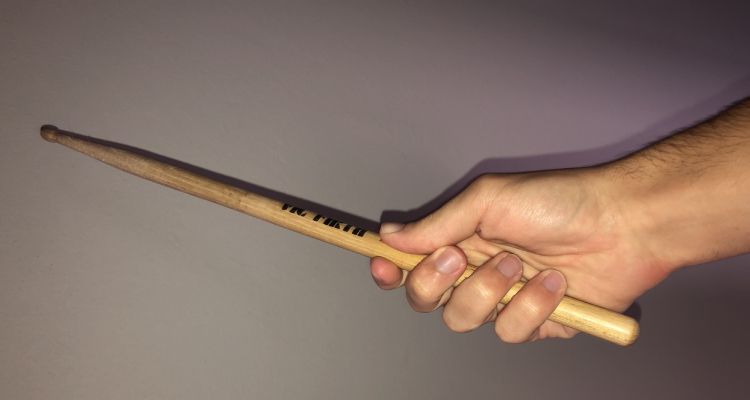
Hitting the Drums Correctly
Now you have set up your drum set, and you know how to hold the drum sticks correctly, you need to ensure proper technique while you strike the drums.
You must let the sticks rebound off the drums when playing. Rebound is a hugely important part of playing technique and it helps drummers achieve faster speeds while playing.
If you dig the sticks into the drums and leave them there, they’re going to choke out the sound. Digging the sticks into the drums will also prevent you from using the rebound to your advantage to play fast patterns.
You should also aim to hit the sticks in the center of each drum, because it obtains the best sound from the drums. If you hit off-center you get a lighter and weaker sound, and it really becomes obvious there are inconsistencies with your playing.
Reading Drum Notation
Now that you’re sitting comfortably at the kit and you know what all the drums are called, you can start learning to play some beats and fills. The easiest way to do this is to learn how to read drum notation.
Having something in front of you to read makes learning much easier at first. Think of how it would be easier to simply read a poem rather than memorize it. That’s why reading is an important skill to have when you’re learning to play the drums.
For now, you just need to know a few things. These include where the drums are placed on a bar and two different types of note values.
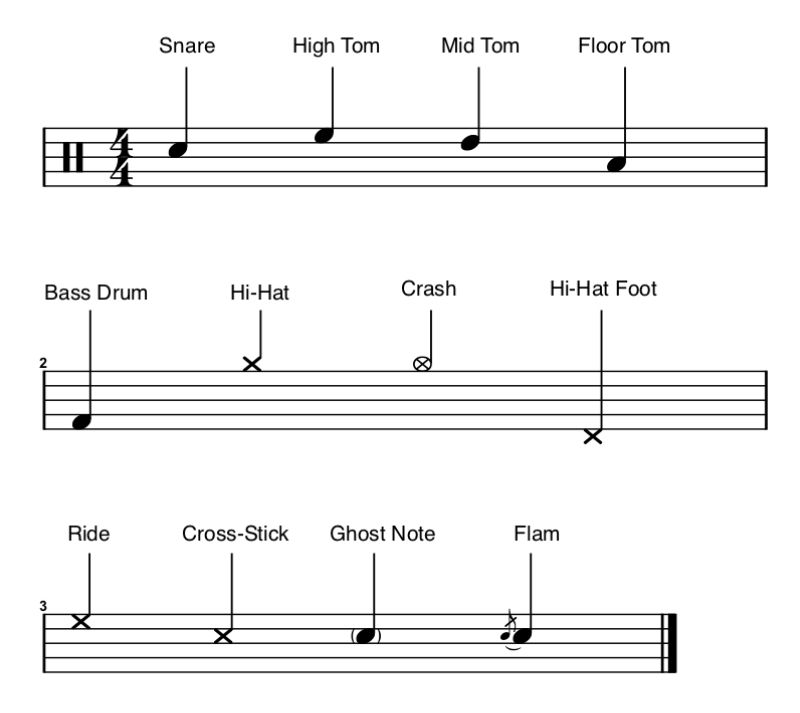
Once you know what all the drums are called, you should learn where they are placed in bars of music.

These are called quarter notes. They count for 1 beat, and there are 4 of them in a bar. They’re the most basic type of note you’ll learn when it comes to drumming.

These are called 8th notes. They hold half the value of a quarter note, meaning there are 2 of them for every 1 quarter. When you see them in a bar, you count them as “1 + 2 + 3 + 4 +”.
Those are the absolute basics of notation reading. You can play a few things on the drums with just that information. However, there is a lot more to note reading. You can check this article out for a more in-depth explanation of it.
Basic Drum Beats
To play basic drum beats, you only need to combine your knowledge of note values along with where the drums are placed on a bar. Let’s look through a few examples.
Basic Beat Example 1

Here’s a simple quarter-note groove. It’s the best place to start in order to get your limbs working together with each other. You play the hi-hat on all 4 counts while playing the bass drum on beats 1 and 3 and the snare drum on 2 and 4.
Remember that the space in between the notes is just as important as the notes themselves, so don’t rush your hands when playing this groove.
Basic Beat Example 2

This is called a straight 8th groove, and it’s arguably the most important thing you’ll ever learn on the drums. Thankfully, it’s quite easy to play! You’re now just filling in all the “+” counts on the hi-hat.
The reason the groove is so important is because it’s the most played groove in the world. There are hundreds, if not thousands, of songs that have this beat. A popular example would be Billie Jean by Michael Jackson.
Basic Beat Example 3

Once you’ve nailed the straight 8th groove, you can experiment with adding extra bass drums to change it up a bit. There are dozens of possibilities when you do this, but here’s one example.
If you want some more basic beats to learn, check out this article.
Basic Drum Fills
Drum fills work the same as grooves, it just takes a bit more brain work to distinguish which drums to play. The more you read the drums around the kit, the better you’ll get at it. Here are some easy examples of basic drum fills.
Basic Fill Example 1

Basic Fill Example 2

Basic Fill Example 3

Tips for Learning the Drums
Find a Drum Teacher
The best idea for anyone wanting to learn the drums is to find a private drum tutor. A teacher will do their best to steer you in the right direction and start you out with good habits. The best part about having a teacher is that they will keep you accountable and correct whatever you are doing wrong.
If you can’t find a teacher, or if you’re concerned about the cost of drum lessons, you should consider signing up for an online drum education platform. Most of them have systems that will keep you going in the right direction.
Set Up a Practice Schedule
It may sound obvious, but practicing the drums is the only way you’re going to improve. Having a structured practice schedule is a great way of developing good practicing habits.
The excitement of drumming may keep you practicing at first, but everyone starts getting lazy over time. So, having an intentional practice routine that you stick to will help you immensely when it comes to getting better at drumming.
Break Your Practicing Down into Sections
There are so many aspects of drumming, leading it to become quite overwhelming at times. A good way of getting through that is to break everything down into different sections. You should choose exactly what to work on.
Here are some drumming topics that are broken down into different sections:
- Grooves
- Fills
- Creativity
- Different Styles of Music
- Timing
- Soloing
Stay Consistent
The biggest benefit of having a steady practice routine is the consistency it gives you. Drumming relies heavily on muscle memory. The more you do something, the more accustomed your body is going to get to it. You’ll find that your limbs will eventually go on autopilot when you’re playing.
You’ll only achieve that by staying consistent and playing as much as possible. Someone who plays drums for 5 minutes a day will always get better than someone who plays for 2 hours every second week.
Use a Metronome
Drummers are the timekeepers of the band. That means that you need to have solid timing and a good sense of rhythm. The best way to develop that is to use a metronome when you’re practicing. A metronome will keep you in time and allow you to internalize different pulses.
Make sure to play beats at different tempos so that you get accustomed to playing drums at different speeds. It’s very common for beginner drummers to play things faster than they need to.
It’s a good idea to play things very slowly at first. This will help in developing your muscle memory. A great way of learning anything on the drums is to play through it slowly, and then gradually increase the tempo of the metronome as you get more comfortable.
Listen to Music
Listening to music is a great way of improving when you’re not sitting at the drum kit. Once you start playing drums, you’ll notice that you’re more aware of what the drums are doing in all the songs you normally listen to.
You’ll find that all the best drummers in the world listen to a lot of music. Doing this will also improve your musicality, which is a great skill to have as a drummer.
Try to discover some drummers that you like, and listen to all the bands that they play in. You may even be able to play along with a few of the songs from those bands.
It will also help you to listen to different styles of music. Doing that will give you an idea of how drumming works in varying settings. Jazz drumming is incredibly different from rock drumming. It can be very interesting to spot the differences. It may even encourage you to learn to play different styles on the drums.
Protect Your Ears
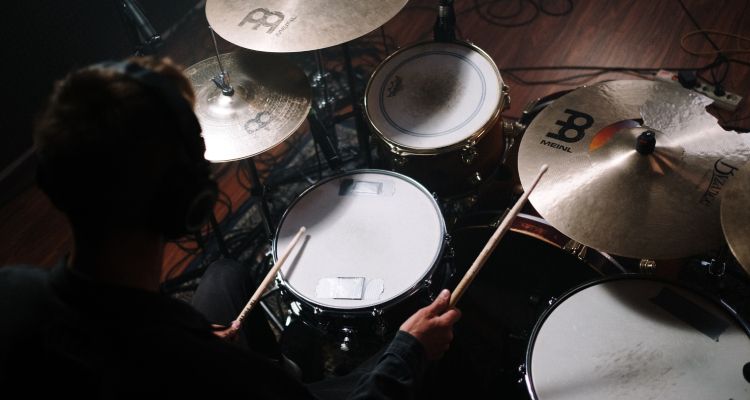
While playing the drums as hard as you can is incredibly satisfying, it’s not good for your hearing. No matter what setting you’re in, a drum kit will always have the potential to damage your ears. It’s incredibly important that you protect your ears when learning the drums.
You can read this article for more information on that and learn what hearing protection you can use while playing the drums.
Play with Other Musicians
Once you’ve learned to play a few grooves and fills, you should try setting up a jam session with some friends who play other instruments. Drums are a supporting instrument, meaning they’re not intended to be played alone.
The real magic in drumming is when you get to play in a band. It’s great to play along to tunes and backing tracks, but that will never beat playing the drums with other musicians in the room.
Playing with other musicians will also force you to improve faster. You’ll find that it puts you on the spot, and you’ll often have to learn new drum parts. It’s a great way of taking everything you’ve learned on the drums and applying it in a music context.
Final Thoughts
There are so many benefits of drumming. It’s an instrument that doesn’t have any limits, meaning anyone can pick up a pair of sticks and learn to play. The great thing about it is that you can play hundreds of songs after your first drum lesson thanks to the basic 8th note groove.
When learning to play the drums, remember to stay consistent and stick to a steady practice routine. If you stay dedicated and motivated, you can get to a high level of playing fairly quickly.
Once you have mastered some basic drum beats and fills, I’d recommend you read my article that covers rudiments as well as some of the other essential drumming techniques which you can find right here!
Best of luck, and happy drumming!


